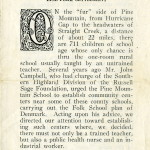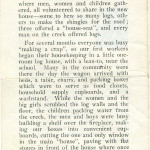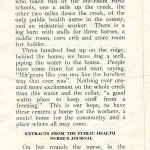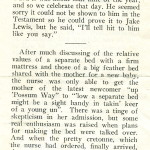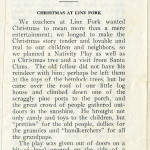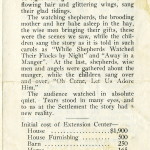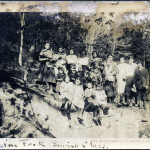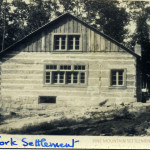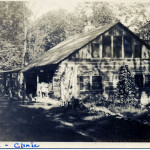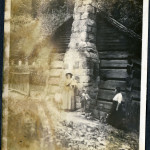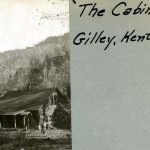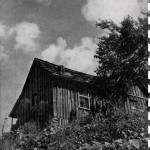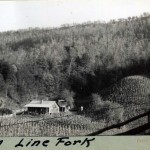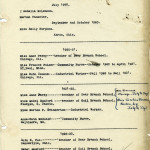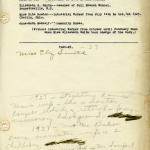Pine Mountain Settlement School
Series 10: BUILT ENVIRONMENT – Medical Settlements
Series 14: MEDICAL, HEALTH & HYGIENE
Line Fork Settlement
1920 – c. 1942
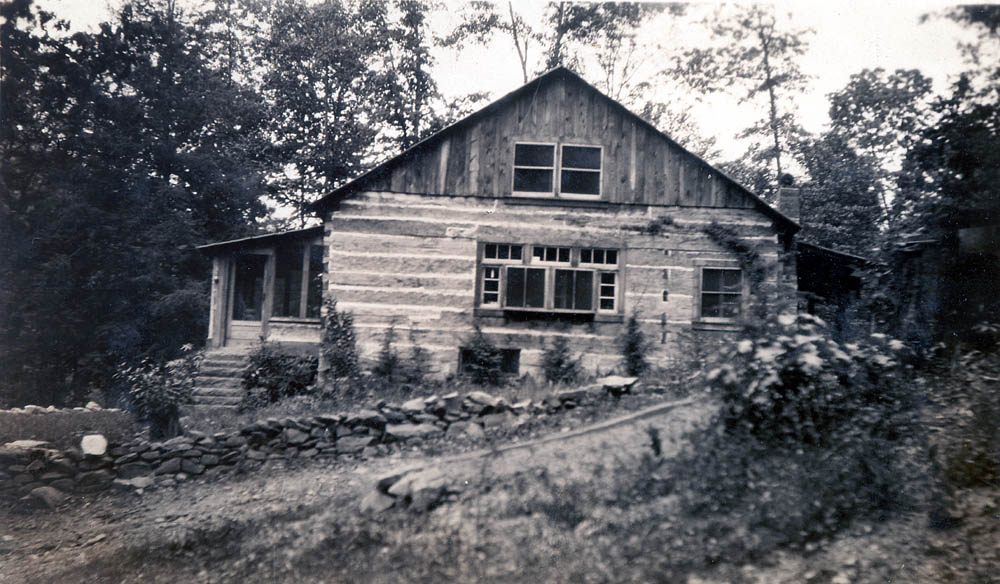
The Cabin at Line Fork Settlement, Gilley, KY, c. 1940s. [kingman010mod.jpg]
TAGS: Line Fork Settlement, Linefork, medical settlements, extension centers, satellite settlements, promotional flyers, maps, Medical Settlement at Big Laurel, women workers, job training, community outreach, moral economy, personal narratives, photograph albums, state and county programs, problems of Appalachia, social services, education, physicians, nurses
LINE FORK Settlement, 1920 – c. 1941
Line Fork Settlement was the second of seven planned extension centers (five centers in ten years is mentioned in a 1918 report) initiated by Pine Mountain Settlement School as they sought to expand their health and education programs into the long Pine Mountain Valley and the surrounding hollows. Line Fork or today, “Linefork,” is an unincorporated community approximately six miles east of Pine Mountain Settlement School [37°1′11″N 82°57′35″W].
The history of the extension center at Line Fork is both rich and deep and many of the records have survived over time. The extension initiative is described in a promotional flyer [see below] written for potential donors during the beginning years of the settlement extension. The brochure describes some of the plans proposed by Katherine Pettit and Ethel de Long for the satellite settlements that would support Pine Mountain’s programs.
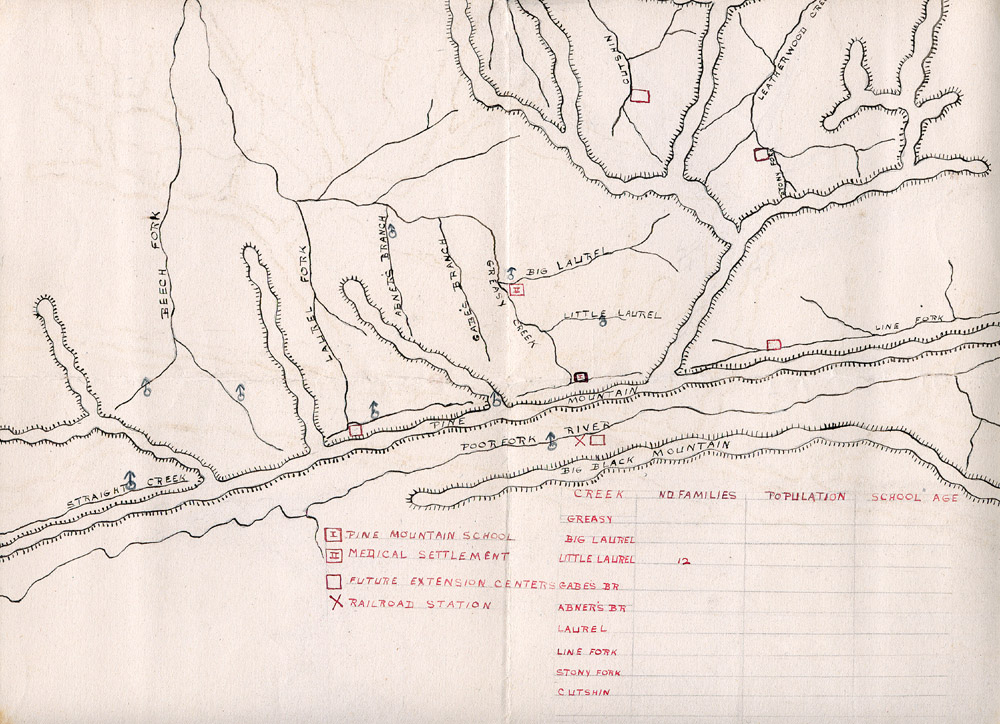
Planned Future Extension Centers, marked as red boxes on the map. Date and origin of map not known; probably prior to July 1920, as Line Fork location is still marked as a “future” extension. Pine Mountain Settlement is near center of map as outlined box in heavy black with “I” in center of the box. Medical Settlement is indicated as in existence as a red box with “II” in center of the box. [map_ext_workmod.jpg]
The views expressed in the early “Line Fork Settlement” brochure rapidly changed as community and settlement workers came to understand more deeply the human conditions that played out during the development years of the extension. In the geographically contained environments at Big Laurel and especially at Line Fork, the medical, educational, and social needs went far beyond what either the workers or the community of interest imagined. The complexity of urban encounters with rural lifestyles pulled into question the underlying social realities of workers and the community. Deeply confounding was the question of what constitutes “improvement,” and what could be measured and prioritized as critical to programming.
GALLERY: Promotional Brochure
- Line Fork Settlement, 1918, p. 1. [line_fork_001a.jpg]
- Line Fork Settlement, 1918, p. 2. [line_fork_002.jpg]
- Line Fork Settlement, 1918, p. 3. [line_fork_003.jpg]
- Line Fork Settlement, 1918, p. 4. [line_fork_004.jpg]
- Line Fork Settlement, 1918, p. 5. [line_fork_005.jpg]
- Line Fork Settlement, 1918, p. 6. [line_fork_006.jpg]
LINE FORK SETTLEMENT: The Workers
The early staff at Line Fork were all women. They were faced with a culture that was unfamiliar to most of them and they were not yet attuned to the challenges of the new environment. Few of them could begin to imagine the adjustments they would need to make while working at the settlement. Eager for the adventure and the possibilities of the new environment, most of the new workers soon found themselves in what they perceived as almost primitive conditions. The initial building of permanent residences, digging wells, and providing for horses and mules as transportation, and gardening were daunting to some who came, but, remarkably, other workers flourished.
The first women at Line Fork were especially challenged and resourceful as they took up residence in tents and in the crude cabin on site at Line Fork in 1920. These early workers included Marguerite Butler [Bidstrup], who, though quite young, had proven herself in the start-up at the main Pine Mountain campus where she arrived in 1914. When she was placed in charge of the development of Line Fork, she was relatively well seasoned. She was placed in charge of supervising the construction of the first cabin at the new settlement. She supervised three local men who constructed the cabin and who assisted in the digging of the well for the site. She left an extensive record of her efforts in a series of letters that cover the Line Fork planning and work from 1919 until 1922.
Additional early workers who found their way to Line Fork during the founding year of the extension settlement included Isabel [or, Isabella] McLennan (McMeekin), Martha Vanmeter, Mary Skidmore, Emily C. Harpham, Ruth Dennis [Langtry], Anne Pavey and Frances Palmer [Conquist]. Their early experiences at Line Fork were the foundation for later workers as they brought new types of approaches to the settlement and to the surrounding community.
Their preconceptions were clearly shattered by their experiences with the life experiences of families on Line Fork. When forced to reconcile their social structures and feelings with the new social structures, culture and feelings of those they served, some grew, while others clearly isolated themselves from the experience. Most adapted and grew.
Katherine Pettit and the staff at Pine Mountain provided assistance. Ester Sandstrom, a nurse at the main campus at Pine Mountain Settlement School, was particularly helpful. Lena Swinerton, who was an assistant to Miss Ruth Gaines at the main campus, also assisted with the development of the new settlement, as did Pine Mountain teachers, such as Miss Ethel Wright and, particularly, Marguerite Butler.
As the program at Line Fork grew, most workers met their challenges head-on, while others limped or left. The turnover at the Line Fork Settlement was one of the issues that Katherine Pettit clearly sought to remedy and understand. The industrial training provided by the settlement staff was intended to address the training issues for the local population but was only partially successful by all accounts. (Today, the problem of training and of skilled labor is still an issue in the region.) The labor force could be found in the people who live in the region, but a shortage of job-training that could keep the population in the area rather than encouraging out-migration was difficult. Further, sustainable access to resources for training was difficult and continues to have a direct impact on the employment of families in the Pine Mountain Valley.
LINE FORK SETTLEMENT: Growth and Lessons Learned
Yet, as the extension at Line Fork and Big Laurel grew and the staff matured, many of the health and educational challenges that Pettit and de Long and the community hoped would be resolved were addressed and family situations gradually improved. Also, living conditions at the settlement for the workers improved. But, the underlying cultural surprises were many in those first social encounters at Line Fork. Fear, pathos, comedy, and sorrow finally merged into empathy for most of the workers and many of their lives and the lives of those they served were changed forever. In the community, old orders and practices gave way to new and family lifestyles soon became a hybrid of practice, new and old. Health was considerably improved and education was greatly expanded but as both were given over to the county of Harlan and the state, conditions began to gradually erode, only to rebound as roads and transportation improved.
The other seven proposed extensions were never fully constructed or fully staffed, mainly due to financial reasons, but the lessons learned from the first two extensions, Big Laurel and Line Fork, provided valuable results and models for rural settlement work among many later settlement schools. The early experiences at Hindman Settlement School experienced by Pettit and de Long and by Harriet Butler, who was recruited from Hindman to Big Laurel, certainly contributed to the foundation of the Pine Mountain extension centers. Certainly, as well, the experiences at Line Fork provided some of the most compelling recorded narratives in the eastern Kentucky rural settlement movement.
The letters, recollections, and reports found in the Pine Mountain Settlement School institutional archive have within them some of the core principles, failures, and successes of settlement community work in a rural environment. The workers at Line Fork were articulate, candid, and engaged and their narratives provide a range of experiences, views, and in-depth reflections of Appalachia from the early 1920s to the late 1940s and a snapshot of the settlement school ethos as it was practiced by a broad spectrum of workers and experienced by a broad range of community.
GALLERY: LINE FORK SETTLEMENT
- School children. Angela Melville Album II. Part III. “Line Fork Sewing Class.”[melv_II_album_133.jpg]
- Angela Melville Album II – Part VII. “Line Fork Settlement.” [melv_II_album_305.jpg]
- Angela Melville Album II – Part VII. “Line Fork – Clinic.” [melv_II_album_322.jpg]
- Angela Melville Album II, Part I. [melv_II_album_029.jpg]
- Line Fork. “‘The Cabin’ – Gilley, Kentucky” with woman standing in front. [nace_II_album_029.jpg]
- [1943_calendar_030_mod.jpg]
- “…on Line Fork.” Distant view of house, cornfield, against mountain. [nace_II_album_030.jpg]
One theme that can be clearly read in the narratives of the settlement workers at Line Fork is a developing and an intense pride in their work. Most saw their work as central to the moral up-raising of the community. But, what could be described as a kind of moral economy was dependent on charity and benevolence as natural acts. This “moral economy” was a fragile building block. Further, as the workers developed a self-assurance that came from the many obstacles that had to be overcome in both the physical as well as the social environments, their enthusiasm could not be sustained against the rising need for higher salaries and greater compensation. The “missionary zeal” that marked the work of women between the wars began to wear thin by the early 1940s. Further, many of the needs of the remote communities began to met by the State and the County of Harlan.
The members of the community, like the workers, shared the pride of work well done. By acknowledging their responsibility for their own improved health and education they found their own voice and their inner resources and many families began to pick up the responsibility for advocating for basic services. Also, many of the children and families in the Line Fork area have stories that balance the narratives of privation, disease, and alcohol addiction, found in the workers’ letters and reports and those local stories have found their way into Appalachian literature and into the “official record” of the region. The archive at Pine Mountain and other Appalachian narratives written by “outsiders,” provided a catalyst for the difficult process of understanding life in one of the most isolated regions of the Appalachians during the active years of the settlement extension work.
Some would say that the “spirit” of improvement certainly had its complications. The “fotched-on women,” who came to show the Line Fork community how things were done and who wrote about it, soon wrote about what they had learned from the community. But, many in the community spread their own perspectives of the “community outreach, ” or, reciprocation, through their oral network. Although oral remembrances within the community have been obscured by time, many persist in family stories in the area and are re-told with delight and often with a deep respect for what they gained from the settlement contacts, work, and education. The fact that many children’s names were derived from those of settlement workers is certainly one testimony to the regard given doctors, industrial workers, nurses, and teachers who worked at both Line Fork and Big Laurel.
The early work of Line Fork Settlement may be read in the first-hand accounts found in REPORTS, LETTERS, and PERSONAL NARRATIVES of the Pine Mountain administrative staff and the workers, listed below.
LINE FORK SETTLEMENT: Guide to Reports of Workers
Most of the personal narratives written by workers and by students who worked with community health and education are found under BIOGRAPHY on this website and in other published accounts. For example, Dr. Alfreda Withington‘s account of her years at the Big Laurel Medical Center can be found in the last chapter her autobiography, Mine Eyes Have Seen (1941). The letters of Marguerite Butler in the institutional archive at Pine Mountain and at John C. Campbell Folk School (where she later moved) detail the building of the Line Fork extension center and the supervision of the well-digging and other demanding construction work. The reports of Dr. Ida Stapleton and commentary by her husband, The Reverend Robert Stapleton, are rich in detail of the late 1920s through the end of the 1930s (1926 – 1937). The Stapleton accounts describe how the Line Fork Settlement adjusted its mission as the community and its needs changed. See the GUIDE TO Dr. IDA STAPLETON & Rev. ROBERT STAPLETON REPORTS for links to the reports.
Many workers wrote engaging narratives or produced photograph albums of their time at the Line Fork and Big Laurel extensions: Martha Van Meter‘s recollections; Ann Ruth Medcalf‘s reports and article; Ann Pavey‘s recollections; Isabel McLannen McMeekin‘s recollections; Emily C. Harpham‘s recollections; Annie R. Lewis’s accounts of her mother Aileene Lewis [Nesbitt] found in Aileene’s photograph album; Dr. Ida Stapleton‘s reports; and the Lutrella Baker Photograph Album (Rev. Richard E. and Lutrella Baker). All are well worth the read and the look!
In the first twenty years of the Pine Mountain Settlement School, the settlement extensions were aggressively promoted and supported by the School. Angela Melville, a development officer at the School, and others raised a remarkable fund (for its time) that was intended to sustain the programs of the extension settlements through an endowment. But, it was not to be. Donations could not be sustained and the needs of Pine Mountain, the First World War, and the Second World War proved too great a strain on the finances of the main settlement at Pine Mountain. As administrations changed, those who promoted and administered the work of the extensions shifted. The attention of the administration at Pine Mountain Settlement in the 1930s focused on physically maintaining the Pine Mountain campus and its growing programs and needs following the retirement of Katherine Pettit. Interestingly, Miss Pettit lived for a brief time at Line Fork following her retirement from Pine Mountain Settlement School. There, she spent her retirement time working with the surrounding community, particularly on agricultural issues.
Later, many of the programs initiated by Pine Mountain Settlement School and its satellite settlements were picked up by county and state agencies. As the road situation improved across and in the Pine Mountain Valley, county and state agencies found it easier to service the region. Travel to regional hospitals improved and the institution of a hospital at Pine Mountain in the late 1940s filled critical health gaps once maintained by the settlements. Also, the Kentucky Department of Education began to attend to the rural school issues and most small schools became fully subsidized by state education programs.
However, the preliminary work completed by the health and education extension services of both Line Fork and Big Laurel provided the framework for important changes in health and in education for families throughout the Eastern Kentucky region. Literacy rates improved. Health literacy reduced the mountain scourges of trachoma (eye disease) and hookworm. Critical surgeries were performed. Further, the public agencies could pick up well-defined health programs and carry them forward with state and county funding without having to start from the beginning.
When Kentucky’s Department of Education became more involved in rural educational needs in the deep hollows of eastern Kentucky after WWII, both in Line Fork and Big Laurel, the agents of change moved with speed toward the rapidly industrializing and changing post-war world.
Unfortunately, in eastern Kentucky, the progress was a stop and go process. As coal and lumbering experienced a boom or a bust, employment waxed and waned. Health issues began to represent the despair of the people and alcoholism was replaced with the mind-numbing drugs of the day or irresponsible prescription of toxic and addictive drugs. Food habits, poor nutrition choices, and obvious “food deserts” have increased the incidence of diabetes and heart disease. Further, the mining practices have severely impacted water supplies and the incidence of heavy metals in the soil is increasing. The rapid development of the natural gas industry and the practice of “fracking” to retrieve the gas, promises to add even more pressure to the deteriorating health and economics of the area.
The rural settlement founders and particularly the doctors and nurses left a permanent imprint on the community and many of the lessons have persisted — but not nearly enough. The many personal accounts by and of the workers who served in either the Line Fork facility or in the Medical Settlement at Big Laurel, clearly demonstrate that the changes they initiated while on site made an impact. The settlement satellites were positive agents for change when social services were rendered in the region of need. Also, in most cases, the workers’ times at the settlements were for them, life-changing. They were imprinted with all the joy, misery, and sometimes terror of their work, but they also became strong advocates for the region. The strength they personally drew from their experiences dominates most of the narratives in this collection, but their pioneering work drew others to the work in the mountains and challenged the state and the country to remedy the closely observed social, cultural and economic problems of Appalachia.
The early years at Line Fork are vividly described in the notes for a History of Pine Mountain 1913-1928, by Evelyn Wells, secretary at Pine Mountain, who used the letters of workers and visitors of the School and the satellite settlements.
From Evelyn Wells, as well as the aggregated letters of workers and Pine Mountain’s director, Katherine Pettit, comes this comment:
This extension center [LINE FORK] was the outgrowth of Miss Marguerite Butler’s extension work on Line Fork for a couple of years. The land was given by the local coal and lumber company, the logs for the house by the community, and the additional necessary funds were raised by Miss Melville in 1919, half of what she raised going to Line Fork, and half to the School Endowment Fund. In this way the solidity of the work at Pine Mountain was balanced by a spreading of influence through the countryside.
The above paragraph aims only at broad outlines, but Miss Pettit has a full and most interesting account of the early days on Line Fork, which should be read in this connection:
In July, 1920, Isabella McClennan [sic McLannan] of Louisville and Martha Van Meter of Lexington went over to Line Fork and taught the Bear Branch School, living in a tiny log house next the school. During the late summer and fall, Miss Marguerite Butler supervised the building of the Settlement Cabin, and that Fall came Miss Anne Pavey, a teacher from Chicago, Miss Frances Palmer, a nurse from Minneapolis, and Miss Ruth Dennis of Chicago as the first permanent staff. In 1921 came Miss Anne Ruth Medcalf [Ann Ruth ??] , a Johns Hopkins nurse, who was head resident for three years. For a while teachers for the Coil [Coyle] Branch and Bear Branch district schools were supplied by Pine Mountain, but since then the community has gotten its own teachers. For this reason partly, the work at Line Fork has not progressed along the same lines as that at Big Laurel, though a comparison of the two Settlements is impossible because of the different underlying economic conditions. Line Fork, like Big Laurel, was fortunate in its early staff and the sound principles on which the work was laid out.
Miss Palmer and Miss Medcalf, being the first public health nurses in Letcher County, were partly supported by the State. Public health work in Whitesburg developed later, so our nurses at Line Fork were no longer eligible for this work. Medical work went on under greater difficulties here than at Big Laurel, there being only the nurse, who often had to work with the local midwife, or some extremely poor doctor from Poor Fork. Miss Medcalf, however, did a good deal of public health work in the schools, instituting hot lunches, for instance, in the face of a good deal of local prejudice, and she did much good and lasting work in the homes. The Cabin as a center of helpful friendliness grew enormously in influence during her stay. There were clinics held by the State Board of Health. There was regular monthly preaching by Dr. Roberts of Harlan. In 1922, the little Health House was built, and the Hall brothers on Bear Branch were started on their broom and stool industry.
In the two years after Miss Medcalf went, the two district schools returned to local influence, being very badly taught by a succession of badly prepared teachers, and there was somewhat of a struggle on the part of the workers at the Cabin to do effective work in the neighborhood. Its doors were always open to the neighbors, and some district visiting went on, but by the time Mr. and Mrs. Stapleton arrived to take charge in 1926, Line Fork had discovered its limitations and had settled down to a less ambitious program.
The letters written by the Stapletons every month, on file in Miss Pettit’s accounts of Line Fork, are full of detail, illuminating conditions at the Settlement in an engaging and, sometimes, intimate manner.
Miss Elizabeth Smith‘s and Miss Ann Ruth Medcalf‘s studies are more sociological in nature. The community as depicted by these two workers stand in contrast to later reports that focus on the fundamental and operational nature of the settlement. Their accounts contain personal perspectives that are informed by their own lifestyles. It was clearly difficult for them to reconcile their familiar environments with the conditions they encountered at Line Fork.
Katherine Pettit writes:
It has been found so hard by Pine Mountain to get the right type of worker to live in an extension center, and to raise funds for its up-keep, that the ideal we had in 1918, five centers in ten years, has not come to pass, though people on Cutshin have asked for workers, and Mr. William Creech has offered us his property on Gabes Branch.
As the staff at Line Fork began to provide services, both educational and medical, they found the far-flung geography, the educational support for a largely illiterate population and their personal tolerance for deprivation profoundly challenging. Learning to live on reduced means with few comforts was for some a “summer camp” experience, but for most who worked at Line Fork, it was an opportunity to grasp the context of their work and to carry it forward with profound commitment and personal grit. Most of the workers met Katherine Pettit’s high bar. Some seem to have exceeded it.
While community life in the Line Fork area was particularly severe for the earliest workers, the improvement in their working conditions and the obvious community uplift were evident in the later years. As roads improved, automobiles were introduced and travel to hospitals was facilitated. Pine Mountain Settlement School had established an Infirmary in 1920 and in the 1950s, West Wind was converted for a brief time into a full hospital. Across Pine Mountain in the hospitals of the coal camps and in Harlan and Cumberland other hospitals and medical centers were established. The Frontier Nursing Service [FNS] at Hyden, Leslie County, established in 1925 by Mrs. Mary Breckinridge, was founded on many of the same models as the Line Fork settlement and the Medical Settlement at Big Laurel. The FNS is still in operation today and has contributed significantly to safe childbirth and health needs in the communities nearby.
As medical care became more accessible and as hospital access grew, the settlement extensions shifted their medical missions and focused more on social service and education. Gradually they declined in usefulness, until they were phased out. The residence of Dr. Stapleton and her husband, The Reverend Robert Stapleton, at Line Fork marked the end of the Line Fork medical era.
Fortunately, many of the personal narratives and photographs from the early years have been retained and they provide first-hand accounts of rural settlement work at its best and sometimes not at its best — but certainly at its most exciting. Perhaps it may be said that Pine Mountain Settlement School’s records provide the most comprehensive account of the rural settlement movement and its health and education work in the Southern Appalachians.
GALLERY: List of Workers, 1920 – 1941
- List of Line Fork Settlement workers, 1920-1937, p. 1. [lin_frk_staff_001.jpg]
- List of Line Fork Settlement workers, 1920-1937, p. 2. [lin_frk_staff_002.jpg]
Transcription: LINE FORK SETTLEMENT – List of Workers, 1920 – 1941
1920
Isabel McLennan (McMeekin) (July 1920)
Martha Vanmeter (July 1920)
Miss Emily Harpham (September and October 1920) Akron, Ohio
1920 – 1921
Miss Anne Pavey (1920 – 1921) Teacher at Bear Branch School. Chicago, Ill.
Miss Frances Palmer (October 1920 – April 1921) Community Nurse. St. Paul, Minn.
Miss Ruth Dennis (Fall 1920 – Fall 1921) Industrial Worker. Chicago, Ill.
1921-1922
Miss Anne Pavey (1920 – 1921) Teacher at Bear Branch School. Chicago, Ill.
Miss [Nellie ?] Simmons (1921 – July to September) Teacher at Bear Branch School. Chicago, Ill.
Miss Mabel Mumford (1921 -1922) Teacher at Coil [Coyle] Branch School. Sturgis, South Dakota.
Miss Caroline Davies (1921 July – September) Teacher at Coil [Coyle] Branch School. Harlan, Ky.
Miss Martha P. Swinnerton (1921-1922) Industrial Worker.
Anne Ruth Medcalf (1921-1922) Community Nurse. Baltimore, Md. [John’s Hopkins]
1922 – 1923
Ruth E. Fox (1922-1923) Teacher of Bear Branch School. Zanesville, Ohio.
Mabel Mumford (1922-1923) Teacher of Coil [Coyle] Branch School.
Miss Annie R. Lewis (1922-1923) Industrial Worker. Lexington, Ky.
Anne Ruth Medcalf (1922-1923) Community Nurse.
1923 – 1924
Ruth E. Fox (1923-1924) Teacher of Bear Branch School.
Elizabeth G. Smith (1923-1924) Teacher of Coil [Coyle] Branch School.
Bennettsville, S.C.
Miss Rita Rebecca Roeder (1923- July 14 to October 1) Industrial Worker. Oberlin, Ohio.
Anne Ruth Medcalf (1923-1924) Community Nurse.
** Without Industrial Worker from October until February when Miss Elizabeth G. Smith took charge of the work.
1924 – 1925 – 1927
Miss Elizabeth G. Smith
Helen Little – 1925
1926
Alice G. Bingham. 5 mos. at Line Fork (correspondence).
Mr. and Mrs. [Richard E.] Baker. Came as minister and wife and 2 children [Mary Sue Baker and Richard E. Baker, Jr.] [According to other sources, they arrived at Line Fork in 1937 and ended in 1941.]
April 1941 – June 1941
Mr. Sanford, artist, in cabin as rental but with no [responsibility to] program.
B. McKnight and Family in cabin as rental. No program.
_______________________________________________________________________
PHYSICIANS and NURSES 1918 – 1928
*Not all nurses and physicians worked at Line Fork but were stationed at the Infirmary at Pine Mountain or at Big Laurel where they could be called into service at any of the three medical stations, as needed.
Briscoe, Mrs. Helen 1918 Nurse
Butler, Harriet 1918-23 Nurse
Davis, Clara 1913-15 Nurse
Huse, Grace 1918-23 Physician
Key, Betty 1927-28 Nurse
Larrabee, Euphemia 1916 Nurse
Lavender, Frances 1918-19 Nurse
Little, Abby N. 1916-18 Physician
Medcalf, Ann Ruth 1921-24 Nurse
Palmer, Frances 1920 Nurse
Purbrick, Marian 1928 Nurse
Roderick, Charlotte 1919 Nurse
Sandstrom, Esther 1919-20 Nurse
Skidmore, Mary 1925 Nurse
Sudo, Maya 1921-24 Nurse
Walker, Margaret 1917-18 Nurse
Withington, Alfreda 1924-28 Physician
RELATED MATERIAL (BIOGRAPHIES)
Dr. Grace Huse
Biography
Mary Ellen Davies
Recollections – “Impressions at Line Fork.”
Mary Sue BakerStudent (Daughter of Rev. Richard E. and Lutrella Baker) – Biography
Lutrella Baker Album Line Fork Settlement
Richard and Lutrella Baker Reports
Isabel McLennan [McMeekin]
Recollections – “Line Fork”
Martha Van Meter
Recollections – “Some Early Experiences at Line Fork.” [11 pages]
Ann Ruth Medcalf
Letters
Reports, January 1922, Feb. 1922
Recollections – “In the Line Fork Country,” magazine article 1924
Elizabeth G. Smith
Reports
Emily C. Harpham
Recollections – “When the Aeroplane Came to Line Fork”
“A Day in a Kentucky Mountain School” (2 pages for December 17, 1920, Bulletin of the College Club of Akron)
Dr. Ida Stapleton & Rev. Robert Stapleton
Letters
Guide to Reports – 1926 – 1936
See Also:
LINE FORK and LITTLE LAUREL Album
LINE FORK SETTLEMENT WORKERS Reports Publications Guide 1921-1941
Return To:
BUILT ENVIRONMENT
BUILT ENVIRONMENT Guide
|
Title |
Line Fork Settlement |
|
Alt. Title |
Line Fork Medical Settlement |
|
Identifier |
Permalink: https://pinemountainsettlement.net/?page_id=2992 |
|
Creator |
Pine Mountain Settlement School, Pine Mountain, KY |
|
Alt. Creator |
Ann Angel Eberhardt ; Helen Hayes Wykle ; |
|
Subject Keyword |
Line Fork Medical Settlement ; Pine Mountain Settlement School ; extension centers ; health ; education ; Cabin ; promotional flyers ; donors ; satellite settlements ; community ; medical workers ; |
|
Subject LCSH |
Melville, Mary Angela, — 1886 – 1977. |
|
Date |
2013-11-11 |
|
Publisher |
Pine Mountain Settlement School, Pine Mountain, KY |
|
Contributor |
n/a |
|
Type |
Collections ; text ; image ; |
|
Format |
Original and copies of documents and correspondence in file folders in filing cabinet related to Big Laurel Medical Settlement |
|
Source |
Series 14: MEDICAL ; Series 10: BUILT ENVIRONMENT ; Series 9: BIOGRAPHY – Staff |
|
Language |
English |
|
Relation |
Is related to: Pine Mountain Settlement School Collections, Series 14: MEDICAL ; Series 10: BUILT ENVIRONMENT ; Series 9: BIOGRAPHY – Staff ; Is related to EXTENSION HISTORY “…a baby hope in the wilderness…” |
|
Coverage Temporal |
1920 – 1980 |
|
Coverage Spatial |
Line Fork Settlement, Gilley, KY ; Medical Settlement at Big Laurel, KY ; Pine Mountain Settlement School, Pine Mountain, KY ; Harlan County, KY ; Little Laurel Settlement, KY ; Linefork, KY ; Wooton, KY ; Harlan, KY ; Letcher County, KY ; Whitesburg, KY ; Cumberland, KY ; Hyden, KY ; Leslie County, KY ; |
|
Rights |
Any display, publication, or public use must credit the Pine Mountain Settlement School. Copyright retained by the creators of certain items in the collection, or their descendants, as stipulated by United States copyright law. Publication use requires the permission of Pine Mountain Settlement School |
|
Donor |
n/a |
|
Description |
Documents, correspondence, writings, and administrative papers pertaining to the Medical Settlement at Big Laurel ; clippings, photographs, books by or about Big Laurel Medical Settlement ; |
|
Acquisition |
n/d |
|
Citation |
“Line Fork Settlement, Gilley, KY.” Series 14: MEDICAL. Pine Mountain Settlement School Institutional Papers, Pine Mountain, KY. |
|
Processed By |
Helen Hayes Wykle ; Ann Angel Eberhardt ; |
|
Last Updated |
2013-12-07 hw ; 2014-05-22 aae ; 2014-06-05 hhw ; 2015-07-22 aae ; 2019-05-20 hhw; 2023-03-29 aae ; 2023-10-17 aae ; |
|
Bibliography |
Pine Mountain Settlement School. 1920. Big Laurel and Line Fork Extension Centers Photographs. Luttrell Collection. Archival material. Pine Mountain Settlement School (Pine Mountain, Ky.). 1918. The history of the Pine Mountain Settlement School; the clothing of an idea with substance. Pine Mountain, KY: n.p. Print. Hamilton, C. Horace. 1959. Health and health services in the southern Appalachians, a source book. Print. Barney, Sandra Lee. Authorized to Heal: Gender, Class, and the Transformation of Medicine in Appalachia, 1880-1930. Chapel Hill: North Carolina Press, 2000. Print. |
Return To:
BUILT ENVIRONMENT

